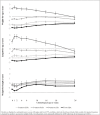Feeding practices and growth patterns of moderately low birthweight infants in resource-limited settings: results from a multisite, longitudinal observational study
- PMID: 36792338
- PMCID: PMC9933750
- DOI: 10.1136/bmjopen-2022-067316
Feeding practices and growth patterns of moderately low birthweight infants in resource-limited settings: results from a multisite, longitudinal observational study
Abstract
Objectives: To describe the feeding profile of low birthweight (LBW) infants in the first half of infancy; and to examine growth patterns and early risk factors of poor 6-month growth outcomes.
Design: Prospective observational cohort study.
Setting and participants: Stable, moderately LBW (1.50 to <2.50 kg) infants were enrolled at birth from 12 secondary/tertiary facilities in India, Malawi and Tanzania and visited nine times over 6 months.
Variables of interest: Key variables of interest included birth weight, LBW type (combination of preterm/term status and size-for-gestational age at birth), lactation practices and support, feeding profile, birthweight regain by 2 weeks of age and poor 6-month growth outcomes.
Results: Between 13 September 2019 and 27 January 2021, 1114 infants were enrolled, comprising 4 LBW types. 363 (37.3%) infants initiated early breast feeding and 425 (43.8%) were exclusively breastfed to 6 months. 231 (22.3%) did not regain birthweight by 2 weeks; at 6 months, 280 (32.6%) were stunted, 222 (25.8%) underweight and 88 (10.2%) wasted. Preterm-small-for-gestational age (SGA) infants had 1.89 (95% CI 1.37 to 2.62) and 2.32 (95% CI 1.48 to 3.62) times greater risks of being stunted and underweight at 6 months compared with preterm-appropriate-for-gestational age (AGA) infants. Term-SGA infants had 2.33 (95% CI 1.77 to 3.08), 2.89 (95% CI 1.97 to 4.24) and 1.99 (95% CI 1.13 to 3.51) times higher risks of being stunted, underweight and wasted compared with preterm-AGA infants. Those not regaining their birthweight by 2 weeks had 1.51 (95% CI 1.23 to 1.85) and 1.55 (95% CI 1.21 to 1.99) times greater risks of being stunted and underweight compared with infants regaining.
Conclusion: LBW type, particularly SGA regardless of preterm or term status, and lack of birthweight regain by 2 weeks are important risk identification parameters. Early interventions are needed that include optimal feeding support, action-oriented growth monitoring and understanding of the needs and growth patterns of SGA infants to enable appropriate weight gain and proactive management of vulnerable infants.
Trial registration number: NCT04002908.
Keywords: community child health; epidemiology; neonatology; nutrition & dietetics; public health.
© Author(s) (or their employer(s)) 2023. Re-use permitted under CC BY. Published by BMJ.
Conflict of interest statement
Competing interests: All authors completed the ICMJE conflict of interest form and were funded by the Bill & Melinda Gates Foundation for this work as part of the LIFE study. ACCL, BAC, CD, CRS, DET, KEAS, K-IB, KLM, KM, MY have received funding from the Bill & Melinda Gates Foundation for maternal and newborn health and nutrition work at large. CD reports other funding from American Society for Nutrition, UpToDate and People’s Medical Publishing House. ACCL reports grants from the WHO and National Institute of Health/ NICHD. BAC reports funding from UNICEF and the US National Health Institutes of Health. MY reports grants from NIH, Emory University, and the Centers for Disease Control. K-IB and KM report grants from the Philips Foundation, the WHO and USAID. SLM has received funding from the International Society for Research on Human Milk and Lactation. All other authors have declared no conflicts of interest.
Figures


References
-
- World Health Organization, United Nations Children’s Fund (UNICEF) . Low birthweight: country, regional and global estimates. World Health Organization, 2004.
-
- Upadhyay RP, Martines JC, Taneja S, et al. . Risk of postneonatal mortality, hospitalisation and suboptimal breast feeding practices in low birthweight infants from rural Haryana, India: findings from a secondary data analysis. BMJ Open 2018;8:e020384. 10.1136/bmjopen-2017-020384 - DOI - PMC - PubMed
Publication types
MeSH terms
Associated data
Grants and funding
LinkOut - more resources
Full Text Sources
Medical
Research Materials
Miscellaneous
